Icelandair, the island nation's national carrier, has been quick to put on a happy face in the wake of the eruption of the Grimsvotn volcano. Within a few days the airline sent out a press release to journalists encouraging coverage of the crisis – and the clean-up operation.
"Most of the country," Icelandair assured us, has been "totally unaffected by the volcanic ash." In fact, the airline seemed to be encouraging foreigners to visit the country as soon as possible, lest they miss out on seeing the ash – or the slowly subsiding eruption – first-hand:
“Curious visitors have already begun to flock to the area, eager to check out the affected area and see the ash for themselves. However, they will have to hurry because the efficient ash clean-up operation is already progressing quickly and local residents hope life in the southeast will be back to normal very soon.
Visits to the crater are not yet allowed, as the eruption has yet to be officially declared finished. But enterprising tour companies are already planning to take advantage of Iceland’s newest geological wonder.”
Eyjafjallajokull – the star volcano of 2010 – is also in South Iceland and tourists have been able to visit that since last summer. It is still one of the most popular tours on offer today and an Eyjafjallajokull museum even opened on the eruption’s first anniversary.
Although Icelandic volcano eruptions caused problems for Europe's other airlines, no carrier had it worse than Icelandair. Airlines never like to see their home airports closed, their planes grounded, and their main destinations unreachable. But there's not much Icelandair can do to stop a volcano from erupting. So it made a lot of sense that the airline would try to turn what seemed to be a major liability into a business opportunity.
With the collapse of its economy in the financial crisis, Iceland is less of a destination for business travelers than it once was. But ecotourism is still a big business – and one with lots of potential. Iceland has whale-watching, hiking, glaciers, and, of course, volcanoes. The Eyjafjallajokull and Grimsvotn eruptions caused problems for Icelandair and Iceland overall. But they also ensured that Iceland would be in the news all over Europe and North America for weeks in both 2010 and 2011. That's no small feat.
The saying is that "there's no such thing as bad publicity." But we might not even need it here: the publicity from the volcanic eruptions hasn't been particularly bad. Yes, people have had their flights cancelled. But no planes have fallen out of the sky, and evacuations and other local problems caused by the eruptions haven't been the focus of the news coverage.
Instead, when non-Icelandic media cover the eruptions, they tend to use pictures and video that make the volcanoes look cool – like something you might want to see for yourself. That's a lot of free media, and a lot of people who will be thinking about Iceland who might not have otherwise.
There's a reason that cable news shows like to air shots of forest fires and tornadoes, and it's not just because television executives are concerned about the people endangered by natural disasters. Producers know that people like to watch that sort of thing. Volcanoes get eyeballs. Icelandair is betting that if they offer folks a chance to see the real thing up close, a bunch of people might take them up on it. It's a good bet.
The Eyjafjallajokull and Grimsvotn eruptions scored Iceland many times more news mentions internationally than anything else in the country's recent history. Is it really so crazy to bet, as Icelandair had, that the eruptions might rebound in Iceland's favor? After all, being known for natural beauty (and danger) is better than being known as a (failed) "Wall Street on the Tundra," right?










